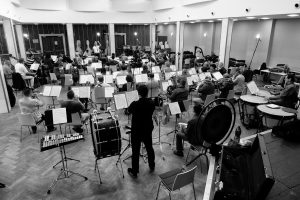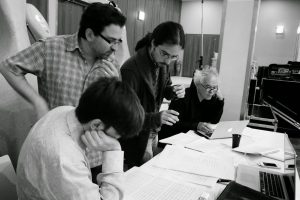The Orchestration and Perception research program involves several projects led by teams at McGill, HEM and IRCAM. Short descriptions of each project are outlined below.
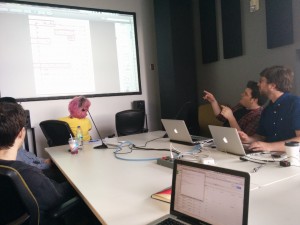
Score and treatise analysis (McGill)
Through analyses of orchestration treatises and scores, we discovered that many orchestration aims are related to auditory grouping processes (McAdams & Bregman, 1979), which organize the acoustic environment and determine what sounds are grouped together into musical events in concurrent grouping, whether these events are connected into musical streams in sequential grouping, and how listeners chunk event streams into musical units such as motifs, phrases, or themes in segmental grouping. We developed a novel taxonomy of orchestration techniques related to these auditory grouping principles and musical structuring: concurrent grouping (blending or separation of instruments), sequential grouping (voice integration or segregation, formation of foreground and background orchestral strata), and segmental grouping (timbral contrasts at local and global levels of form).
This taxonomy served as a guide for the development of a systematic empirical approach to orchestration analysis combining score analysis and listening. Pairs of researchers analyzed each movement: after analyzing the movement individually, they compared analyses and developed a joint analysis, which consisted of an annotated score and a spreadsheet that catalogued various details about each instance of the orchestral effects. These data include the span of measures in which the device is found, the timing of the recording(s), the instrumentation, and the perceived strength of the effect. At large team meetings, each pair shared their analyses and the issues were discussed as a large group, working collaboratively to develop the definitions and analysis approach in an ongoing process.
We are currently integrating the annotations, analyzed PDFs, and sound files into an online, research tool: the ORCHestration Analysis and Research Database (Orchard), which will soon contain 4439 annotations of orchestral effects within 85 full movements of orchestral pieces (1787-1943). Each annotation can be viewed on a detail page, which contains information about the composer, work, movement, measures, instrumentation, and a brief description. You can view the annotated score and listen to a short sound clip. This first-of-its kind database will allow researchers to explore and study orchestration practices at play. Please contact us to learn more about using Orchard.
OrchSim, OrchPlay and the OrchPlay Music Library (OrchPlayMusic)
https://youtube.com/watch?v=FqIRduj1aL4+
OrchSim
OrchPlayMusic is developing new technologies for music education and appreciation related to orchestration practice through the online multitrack OrchPlay Music Library of significant orchestral excerpts. These excerpts are created with the hyper-realistic orchestral rendering environment OrchSim that produces multitrack recordings comparing favourably to professional orchestral recordings, complete with spatialization of the instruments, concert hall room acoustics, and ambient noise context.
OrchSim ties together in a coherent whole some of the best virtual instruments with the expertise of professional performers. All OrchSim recordings are produced in true multitrack format, enabling the selection of each instrument individually that can be heard from their specific location on stage and in the acoustics of the hall. The recordings are made in 24-bit audio format and then converted to the .OPL proprietary format that can be played by the OrchPlay software.
OrchPlay
The OrchPlay software plays the multitrack OrchSim files and provides access to all individual instrumental tracks of the full orchestra thus enabling subsets of instruments involved in a particular orchestral effect to be heard in isolation or within the full musical context. The tool provides unprecedented opportunities for scientific research on orchestration perception, for computational modelling of orchestration techniques, and for orchestration pedagogy and performance practice (orchestral players can rehearse their parts at home with a full orchestra in a “Music Minus One” fashion).
Any user’s instrumental setting related to any section of a score (with measure # and time-based units) can be saved as a bookmark with individual name, description and relevant score pages for research, use in the classroom or public presentations. Bookmarks and Bookmarks Lists (referring to any compilation of pieces) can also be exported and shared with all other users. Standard stereo files can be imported as OPL files as well as any other related document and linked to them.
The OrchPlay Music Library currently offers a selection of 100 musical pieces (from short excerpts to full movements) from the symphonic repertoire from late 18th Century to Contemporary. The selection is planned to feature a growing number of complete movements and expand to over 400 significant orchestral masterworks within a few years. The goal is to provide an international reference database of multichannel orchestral recordings accessible to the widest public possible. The web user interface allows for the selection of excerpts on the basis of composer, historical period, type of instrumentation (classical, romantic, modern, etc.), musical form and – soon to come- the type of orchestration effect or technique being sought (close collaboration with Orchard). For more information, see https://www.orchplaymusic.com/
Nouveaux outils d’aide à l’orchestration pour la création et la pédagogie (HEM)
New tools for computer-aided orchestration dedicated to creation and pedagogy (HEM)
La Haute école de musique de Genève (HEM) s’est engagée depuis plusieurs années dans un travail de réflexion et de recherche autour de l’aide à l’orchestration et de ses applications pédagogiques, destinés en particulier aux étudiants des classes d’orchestration et de composition.
Nous pensons que l’ordinateur peut jouer un rôle déterminant en s’adaptant et en répondant aux besoins des orchestrateurs, des compositeurs et des pédagogues. En effet, nous disposons aujourd’hui de grandes banques d’échantillons sonores, et les avancées considérables en termes d’analyse du signal acoustique et de perception du timbre permettent de repenser la question de l’orchestration. Il ne s’agit en aucun cas de substituer l’ordinateur au papier mais de promouvoir une pratique d’écriture basée en partie sur une dimension numérique, utilisant en particulier le calcul, comme dans d’autres disciplines de la musique. Le domaine de l’orchestration est resté jusqu’il y a peu de temps une des seules disciplines musicales à ne pas avoir bénéficié pleinement des avancées de l’informatique, compositeurs et orchestrateurs manquent donc encore aujourd’hui de moyens adaptés. Sur le plan pédagogique, la transmission du savoir orchestral se fait encore beaucoup par voie orale, les traités d’orchestration sont pour la plupart datés, obsolètes, ou ne reflètent pas les enjeux esthétiques de notre siècle ; l’orchestration reste finalement encore un savoir-faire empirique dont l’acquisition et la maîtrise demandent de nombreuses années de pratique.
La HEM a déjà collaboré avec l’Ircam pour la réalisation du logiciel Orchis/Orchidée, qui permet de créer des alliages statiques de timbres dans un contexte musical donné ; elle a également conçu le logiciel Pleione, application à usage pédagogique permettant de naviguer de manière structurée à travers des bases de timbres. De nombreuses expérimentations ont déjà eu lieu au sein de la Haute Ecole de Musique, réalisées d’abord en simulations puis confrontées et validées par de véritables orchestres. Le grand intérêt qu’elles ont suscité dans la sphère musicale, ainsi que les limitations de ces outils nous encouragent à aller plus loin dans la recherche : le projet e-Orch, financé par le NFS (Swiss National Fondation) va permettre de faire appel à de nombreuses compétences, qu’elles soient scientifiques, musicales, psycho-acoustiques, computationnelles, etc. La pratique traditionnelle de l’orchestration se verra donc enrichie par l’interaction avec un système informatique capable de représenter et d’organiser des connaissances musicales liées au timbre. Pour ce faire, il est indispensable de mieux comprendre les différents aspects liés aux mélanges de timbres, de les modéliser puis de disposer d’une interface d’exploration et de du timbre complète et intuitive. Ce nouvel outil conduira ainsi les étudiants à mieux comprendre les rapports complexes entre les variables symboliques de l’écriture et les qualités de timbre des mélanges instrumentaux. Cette recherche nécessite de nombreux moyens et de larges connaissances dans de nombreux domaines, apportées grâce au précieux concours de deux partenaires importants, l’Ircam et McGill.
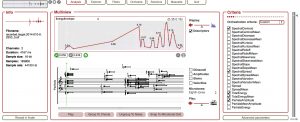
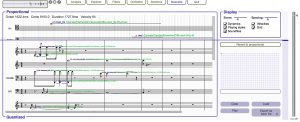
Computer-aided orchestration (IRCAM)
Orchids is the first complete system for abstract and temporal computer-assisted orchestration and timbral mixture optimization. It provides a set of algorithms and features to reconstruct any time-evolving target sound with a combination of acoustic instruments, given a set of psychoacoustic criteria. It can help composers to achieve unthinkable timbral colors by providing efficient sets of solutions that best match a sound target. With our extended set of features, it can now also reproduce abstract spectral descriptors movements (bypassing the need for a sound file) by combinations of any sounds. Its results provide multiple orchestral scores that can be arranged in a timeline in order to perform a fast sketching of musical ideas. The new system provides several algorithms for approximating jointly several timbre properties. The advantages of the Orchids system is that this approximation can be made separately over temporal shapes, mean values or standard deviations (or any combinations of the three) of each psychoacoustic descriptor. Furthermore, users can also defines a manual temporal warping, and even perform multiple search inside parts of a sound, quickly providing full orchestral pieces in seconds. The new system provides an extensive out-of-the-box database of orchestral possibilities but can also be unlimitedly extended, even with synthesis sounds, by a simple drag-and-drop operation. Finally, the software provides an intelligent time series querying system that allow to easily search for temporal shapes inside the sound database.
For more information, see http://repmus.ircam.fr/orchidee
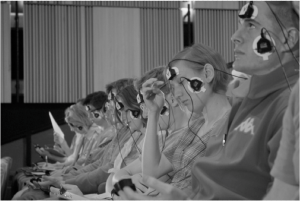
Perceptual Experiments (McGill)
The aim of perceptual experiments is to test potential theories and principles of orchestration that are revealed through our score and treatise analyses. Our goal is to understand the contexts in which certain orchestration effects emerge and the performance conditions that enhance or reduce these effects. These results will assist us in refining and re-evaluating the orchestration principles, which will lead to perceptually based theories. Re-orchestrations and re-compositions allow researchers to illuminate the role of various choices in orchestration and composition. We conducted a study which the spectral centroid (connected to timbral brightness) was modified independently through adjustments in instrumentation in order to explore its interaction with other musical parameters. We are investigating the strategies of the re-orchestrations, their efficacy in specific musical contexts, and the theoretical implications of the alternate versions (Goodchild, 2016). We have also conducted a series of experiments on the musical factors that contribute to the blending of instrument timbres and another series is in progress on the musical factors that affect the segregation of instruments or instrumental groups into auditory streams or planes of tone.
The OrchSim system and the multitrack recordings of the OrchPlay Music Library allow the Orchestration and Perception Project team to proceed with perceptual experimentation and acoustic analyses verifying specific hypotheses concerning orchestration techniques, such as the role of timbral contrasts in structuring musical form in existing orchestrations or re-orchestrations. The new possibility offered by OrchPlay to extract and alter passages of an orchestral texture in an environment where all parameters can be individually controlled and the possibility to test specific instrumental combinations perceptually both in isolation and in their original musical context contributes to the understanding of their roles and interplay in the studied orchestral effects such as blend, segregation and segmentation.



